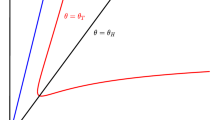Abstract
A diffusive predator-prey model with modified Leslie-Gower term and Michaelis-Menten type prey harvesting subject to the homogeneous Neumann boundary condition is considered. We obtain the local and global stability of constant equilibria by eigenvalue analysis and iteration technique. Choosing some parameter concerning with harvesting as Hopf bifurcation parameter, we conclude the existence of periodic solutions near positive constant equilibrium. Using the normal form and center manifold theory, and numerical simulations, we demonstrate our theoretical results of stability and direction of periodic solutions. We also derive the non-existence and existence of non-constant positive steady states by energy method and degree theory.

Similar content being viewed by others
References
Holling, C.S.: The functional response of predator to prey density and its role in mimicry and population regulation. Mem. Ent. Sec. Can. 45, 1–60 (1965)
Xiao, D., Ruan, S.: Bogdanov-Takens bifurcations in predator-prey systems with constant rate harvesting. Fields Inst. Commun. 21, 493–506 (1999)
Peng, G.J., Jiang, Y.L., Li, C.P.: Bifurcations of a Holling-type II predator-prey system with constant rate harvesting. Int. J. Bifurc. Chaos Appl. Sci. Eng. 19, 2499–2514 (2009)
Ji, L., Wu, C.: Qualitative analysis of a predator-prey model with constant-rate prey harvesting incorporating a constant prey refuge. Nonlinear Anal., Real World Appl. 11, 2285–2295 (2010)
Xiao, D., Jennings, L.S.: Bifurcations of a ratio-dependent predator-prey system with constant rate harvesting. J. Appl. Math. 65, 737–753 (2005)
Huang, J.C., Gong, Y.J., Ruan, S.G.: Bifurcation analysis in a predator-prey model with constant-yield predator harvesting. Discrete Contin. Dyn. Syst., Ser. B 18(8), 2101–2121 (2013)
Leard, B., Lewis, C., Rebaza, J.: Dynamics of ratio-dependent predator-prey models with non-constant harvesting. Discrete Contin. Dyn. Syst. Ser 1(2), 303–315 (2008)
Lenzini, P., Rebaza, J.: Non-constant predator harvesting on ratio-dependent predator-prey models. Appl. Math. Sci. 4(16), 791–803 (2010)
Das, T., Mukherjee, R.N., Chaudhari, K.S.: Bioeconomic harvesting of a prey-predator fishery. J. Biol. Dyn. 3, 447–462 (2009)
Gupta, R.P., Chandra, P.: Bifurcation analysis of modified Leslie-Gower predator-prey model with Michaelis-Menten type prey harvesting. J. Math. Anal. Appl. 398, 278–295 (2013)
Clark, C.W.: Aggregation and fishery dynamics: a theoretical study of schooling and the purse seine tuna fisheries. Fish. Bull. 77, 317–337 (1979)
Alaoui, M.A., Okiye, M.D.: Boundedness and global stability for a predator-prey model with modified Leslie-Gower and Holling-type II schemes. Appl. Math. Lett. 16, 1069–1075 (2003)
Song, X., Li, Y.: Dynamic behaviors of the periodic predator-prey model with modified Leslie-Gower Holling-type II schemes and impulsive effect. Nonlinear Anal., Real World Appl. 9, 64–79 (2008)
Ji, C., Jiang, D., Shi, N.: Analysis of a predator-prey with modified Leslie-Gower and Holling-type II schemes with stochastic perturbation. J. Math. Anal. Appl. 359, 482–498 (2009)
Nie, L., Teng, Z., Hu, L., Peng, J.: Qualitative analysis of a modified Leslie-Gower and Holling-type II predator-prey model with state dependent impulsive effects. Nonlinear Anal., Real World Appl. 11, 1364–1373 (2010)
Aziz-Alaoui, M.A.: Study of a Leslie-Gower-type tritrophic population. Chaos Solitons Fractals 14, 1275–1293 (2002)
Korobeinikov, A.: A Lyapunov function for Leslie-Gower predator-prey models. Appl. Math. Lett. 14, 697–699 (2002)
Li, X., Jiang, W.H., Shi, J.P.: Hopf bifurcation and Turing instability in the reaction-diffusion Holling-Tanner predator-prey model. IMA J. Appl. Math. 78(2), 287–306 (2013)
Zhou, J., Shi, J.P.: The existence, bifurcation and stability of positive stationary solutions of a diffusive Leslie-Gower predator-prey model with Holling-type II functional responses. J. Math. Anal. Appl. 405(2), 618–630 (2013)
Zhou, J.: Positive solutions of a diffusive predator-prey model with modified Leslie-Gower and Holling-type II schemes. J. Math. Anal. Appl. 389(2), 1380–1393 (2012)
Zhou, J., Kim, C.G., Shi, J.P.: Positive steady state solutions of a diffusive Leslie-Gower predator-prey model with Holling type II functional response and cross-diffusion. Discrete Contin. Dyn. Syst. 34(9), 3875–3899 (2014)
Yang, W.S.: Global asymptotical stability and persistent property for a diffusive predator-prey system with modified Leslie-Gower functional response. Nonlinear Anal., Real World Appl. 14(3), 1323–1330 (2013)
Wang, M.X., Pang, P.Y.H.: Global asymptotic stability of positive steady states of a diffusive ratio-dependent prey-predator model. Appl. Math. Lett. 21, 1215–1220 (2008)
Hassard, B., Kazarinoff, N., Wan, Y.H.: Theory and Applications of Hopf Bifurcation. Cambridge University Press, Cambridge (1981)
Yi, F.Q., Wei, J.J., Shi, J.P.: Bifurcation and spatiotemporal patterns in a homogeneous diffusive predator-prey system. J. Differ. Equ. 246, 1944–1977 (2009)
Chang, X.Y., Wei, J.J.: Stability and Hopf bifurcation in a diffusive predator-prey system incorporating a prey refuge. Math. Biosci. Eng. 10, 979–996 (2013)
Lou, Y., Ni, W.M.: Diffusion, self-diffusion and cross-diffusion. J. Differ. Equ. 131, 79–131 (1996)
Pang, P.Y.H., Wang, M.X.: Strategy and stationary pattern in a three-species predator-prey model. J. Differ. Equ. 200, 245–273 (2004)
Nirenberg, L.: Topics in Nonlinear Functional Analysis. American Mathematical Society, Providence (2001)
Pang, P.Y.H., Wang, M.X.: Non-constant positive steady states of a predator-prey system with non-monotonic functional response and diffusion. Proc. Lond. Math. Soc. 88(3), 135–157 (2004)
Acknowledgements
The authors would like to thank an anonymous referee for some helpful comments.
Author information
Authors and Affiliations
Corresponding author
Additional information
This work was supported by NSFC Grant 11371113.
Appendix: Direction of Hopf Bifurcation
Appendix: Direction of Hopf Bifurcation
In this appendix, we compute \(\operatorname {Re}c_{1}(h_{H}^{j})\). We adopt the same notations of [25]. When \(h=h_{H}^{j}\), we set
where
When j≠0, we get
So it remains to calculate
It is straightforward to compute that
with
From computations, it follows that
where
Then
where
Hence,
where
where \(\xi^{R}=\operatorname{Re} \xi\), and \(\xi^{I}=\operatorname{Im} \xi\).
Likewise, when j=0, we derive \(\tilde{A}=\rho\), and
Rights and permissions
About this article
Cite this article
Li, Y., Wang, M. Dynamics of a Diffusive Predator-Prey Model with Modified Leslie-Gower Term and Michaelis-Menten Type Prey Harvesting. Acta Appl Math 140, 147–172 (2015). https://doi.org/10.1007/s10440-014-9983-z
Received:
Accepted:
Published:
Issue Date:
DOI: https://doi.org/10.1007/s10440-014-9983-z




